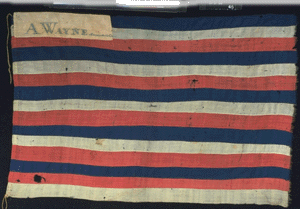
The General Anthony Wayne Flag is on loan to the Eiteljorg Museum in its exhibit Mihtohseenionki: The People’s Place until April 27, 2016.
The following article appeared in the Indiana History Bulletin, July 1937, vol. 14, No. 7, p. 207.
Greenville Treaty Flag
The Historical Bureau has placed on display on the first floor of the State Library and Historical Building the oldest United States flag in the state, a short notice of which was printed in the January Bulletin. The flag is made of domestic bunting, is approximately 5 feet fly by 3 feet, 8 inches hoist, and consists of 15 stripes of red, white, and blue. It is the only known remaining example of the flags presented by General Anthony Wayne to Indian chiefs at the Treaty of Greenville.
General Wayne, after the disastrous defeat of Governor Arthur St. Clair, had been appointed commanding general of the armies of the United States and had decisively defeated the Indians under Little Turtle at Fallen Timbers , southwest of Toledo. The following year (1795) most of the chiefs in the Old Northwest accepted his invitation to talk peace at Greenville. The various treaties which were made there were among the most important ever concluded between the United States and the Indians. They gave the United States title to land along the Ohio River down to the mouth of the Kentucky, and security to the settlers of Ohio, Michigan, Indiana, and Illinois for fifteen years.
Among the Miami chiefs present at the Treaty was one who signed it under the name Soldier. This chief was called, in the language of his people, She-Moc-E-Nish. His village was at or near the site of the present Thorntown. It was a tradition among his people that Anthony Wayne, when he gave the flag, said: "Keep this flag in sight and as often as you see it, remember we are friends." This flag was handed down to a granddaughter of She-Moc-E-Nish, Kil-So-Quah (meaning Setting Sun), who lived near Roanoke, Indiana. She died September 4, 1915, at the reputed age of one hundred and five years and was said to be the oldest full-blooded Miami Indian in the state.
The flag had previously passed into the possession of another granddaughter of She-Moc-E-Nish, a Mrs. Dixon. It was secured from Mrs. Dixon's daughter Mary by the late Dr. Perry G. Moore, of Wabash, Indiana. Dr. Moore died June 9, 1931, at the age of eighty-six years, bequeathing the flag to the Indiana Historical Bureau.
Dr. Moore practised medicine for many years at Rich Valley and attended many of the Miami Indians who were still living in the upper Wabash Valley. He first learned of the flag in the summer of 1868 when he was attending James Aveline who was fatally ill at the home of his Indian wife. Aveline's white wife, who had come from Fort Wayne, acted as interpreter. At that time the flag was in the possession of Mrs. Dixon, a cousin of the Indian wife of Aveline. Mrs. Dixon showed him the flag, but he was not able to purchase it from her until later.
